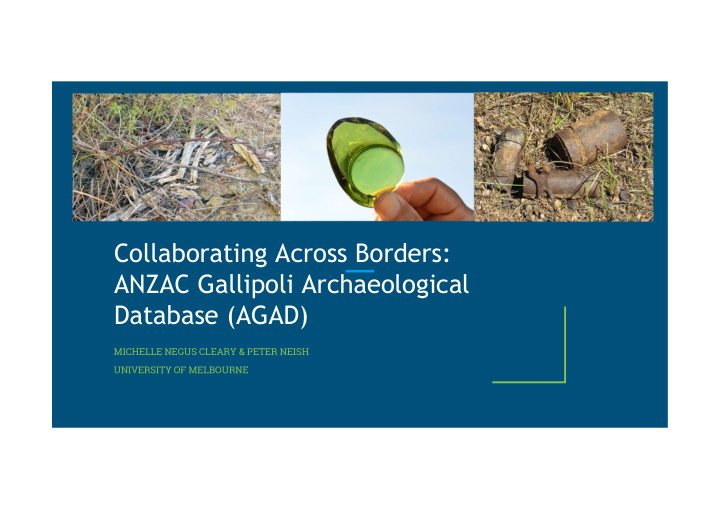



Collaborating Across Borders: ANZAC Gallipoli Archaeological Database (AGAD) MICHELLE NEGUS CLEARY & PETER NEISH UNIVERSITY OF MELBOURNE
agad.anzac.unimelb.edu.au
ANZAC Gallipoli Archaeological Database ➢ A key resource for academics, amateur historians, and the general public ➢ No other online database of WW1 material culture currently exists ➢ An extensive catalogue of all artefacts and features recovered during the 2010 – 2014 surveys ➢ Forms a well-documented archive of artefacts and features from accurately recorded archaeological contexts ➢ Includes descriptions, dimensions, photographs and maps ➢ Ties into the JHAS research outputs (book and exhibition)
Joint Historical-Archaeological Survey (JHAS) Surveys of the Gallipoli battlefield: ➢ Using archaeological techniques to document the remains of the best preserved World War 1 battlefield. ➢ Aims to identify and record sites and features of significance to Australian, New Zealand, and Turkish forces during the 1915 campaign. ➢ Integration of archaeological techniques, methods and analysis with historical data. ➢ To record and conserve material culture associated with the 1915 campaign that is visible on the ground surface. ➢ A cultural heritage assessment of the battlefield a century after the conflict. The ANZAC Gallipoli Archaeological Database (AGAD) is a digital catalogue of all features, finds and sites documented by the JHAS Gallipoli survey project from 2010 – 2014.
Collaboration JHAS Project: Tri-national collaboration Australia ● ● Turkey ● New Zealand Inter-disciplinary: ● Archaeologists Historians ● ● Geophysicists Heritage Managers ● ● Resource management agencies ● Government agencies ● Universities
JHAS
JHAS surveys
Features ❑ Earthworks: ❑ trenches ❑ tunnels ❑ terraces ❑ dugouts, pits, & alcoves ❑ strategic positions ❑ Artefacts: ❑ ordnance ❑ ceramics ❑ metal items, tools and containers ❑ glass containers and periscope glass ❑ bricks, barbed wire, personal & utility items ❑ Other: ❑ e.g. water tanks, a boat, pre- and post-1915 structures ❑ Post-1915 cemeteries and monuments
Trench Trench F748 F769
Lexicon Artefact Feature Type Location Artefact Type Material Period Alcove 57th Regiment Barbed wire Ceramic Post- 1915 Artefact Baby 700 Brick Concrete c. 1915 Artefact Scatter Battlefield general Ceramic sherd Glass Pre-1915 Boat Boundary Glass shard Leather Modern Boundary Marker Coastal area Glass periscope Metal Early Modern Carpark Courtney's Post Lithic Stone Medieval Cemetery Embarkation Pier Metal container Textile Early Medieval Dugout German Officer's Metal fragment Other Late Antique Monument Holly Ridge Ordnance Antique Pathway Johnston's Jolly Personal Item Classical Pit Lone Pine Shrapnel Iron Age Road Malone's Terraces Tile Late Bronze Age Strategic Position The Nek Utility item Middle Bronze Age Structure built Pope's Hill Other Early Bronze Age Terrace Quinn's Post Unknown Chalcolithic Trench Seaview Terrace Neolithic Tunnel Silt Spur Palaeolithic Water tank Turkish Quinn's Well Walker's Ridge Other Weir Ridge more…
agad.anzac.unimelb.edu.au
Survey locations
AGAD Challenges Challenges inherited from the JHAS Project: ● Language: translation and difficulty in collaboration in same place ● Sensitivity of content Political issues ● AGAD Need to restrict public access to aspects of the dataset to protect heritage of the Gallipoli ● battlefield as a historical landscape Finding a long-term host and custodian for the online resource ●
Details of ongoing custodianship At present the AGAD is hosted by the University of Melbourne. However, there is a limited funding horizon. The primary dataset resides with individual researchers and with the Department of Veterans’ Affairs, Canberra. Future home at the Australian War Memorial?
Data Curation Activities FileMaker database not preservable in current state ● Wanted to separate concerns between data and display ● ● Wanted data to persist beyond current system - exit strategy ○ ○ long-term preservation Created a Data Management Plan ● Highlighted ongoing custodianship issues ○ Application of cc-by licence for data and images ○
Data Manipulation Data Export to Data Database Cleaning Created SQL CSV (open refine) Image File Thumbnail Embed Images renaming generation metadata CMS
Database structure
Summary agad.anzac.unimelb.edu.au ● AGAD operates as an unique, interactive appendix that presents the primary data and results of the JHAS project. Provides a comprehensive record of the state of the ANZAC Gallipoli 1915 battlefield one ● hundred years after the conflict. ● Challenges in terms of collaboration across three nations involved in the original conflict: language; funding and contribution; sensitive information, interpretation and use of terms. Limitation was built into the AGAD to only provide limited spatial information in order to ● protect the actual battlefield from looters. ● Challenges for ongoing funding and long-term host and custodian of the raw dataset. Limited funding horizon at present. Aims for long-term preservation of the AGAD database. ●
Acknowledgements The AGAD website is dedicated to the late Antonio Sagona Contributors: Antonio Sagona, Sarah Midford, Jessie Birkett-Rees, Abby Robinson, Simon ● Harrington, Leo Konstantelos and Anna Shadbolt ● Dr Rebecca Flemming, Department of Veterans’ Affairs, Canberra Department of Veterans’ Affairs, Canberra ● Manatū Taonga Ministry for Culture and Heritage, New Zealand ● ● Onsekiz Mart Universitesi, Canakkale, Turkey ● Turkish Ministry of Culture and Tourism Turkish Ministry of Foreign Affairs ● Turkish Ministry of Environments and Forests ● ● The University of Melbourne
Recommend
More recommend